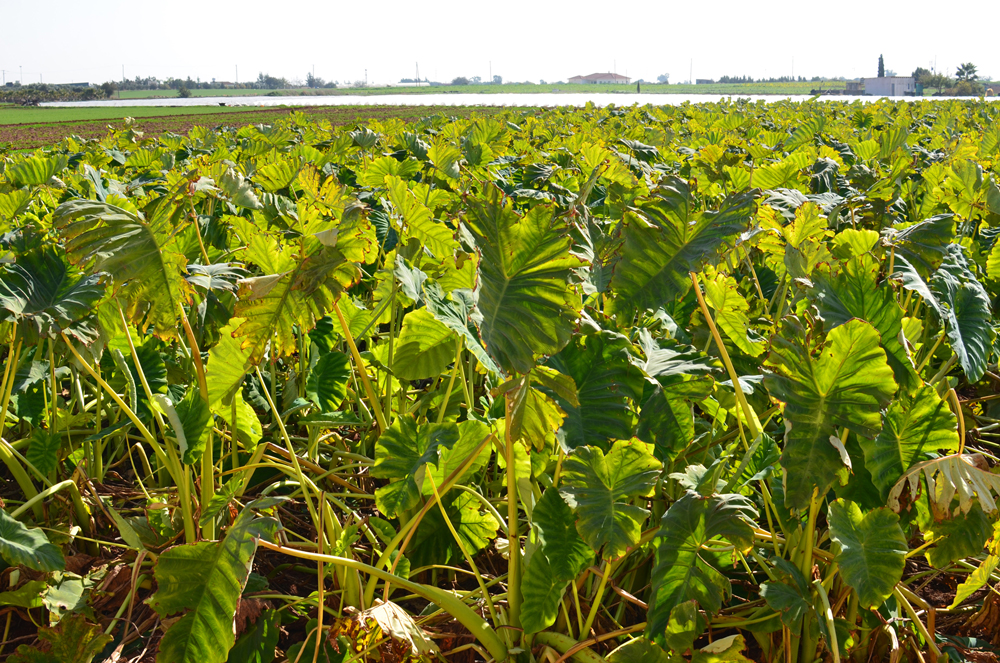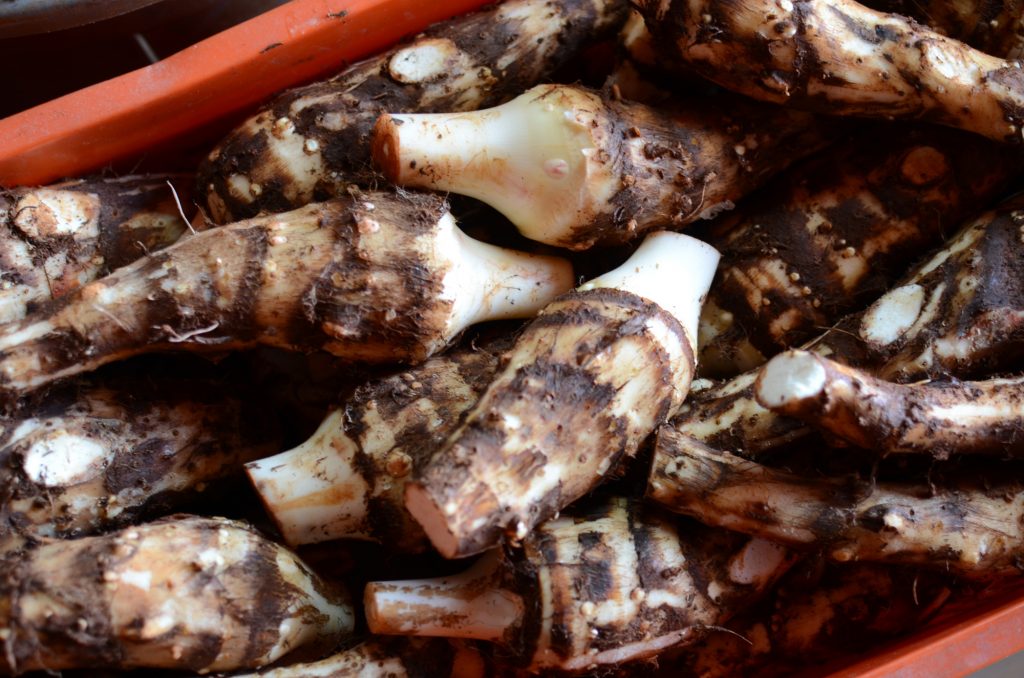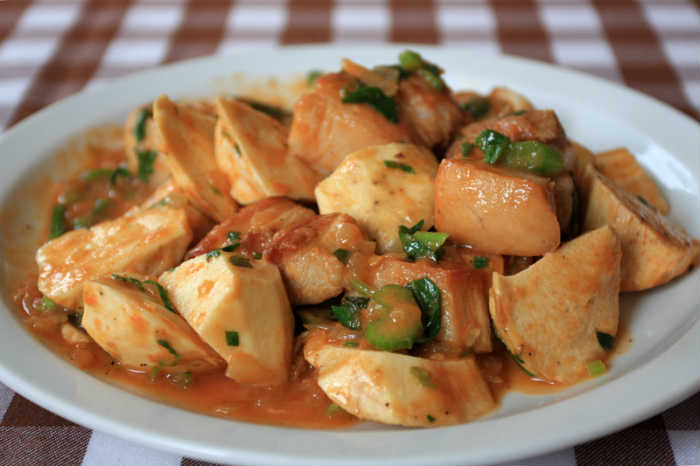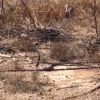The story with the THOC play "Cock" may have been a black page for the Savior, but the community has something to be proud of. Since August 2016 it has become synonymous with the most famous courgette in Cyprus!
A product which until a few years ago was of secondary importance at the Cypriot table and which today is promoted as a gourmet dish in good restaurants. A dish of fried zucchini with oregano instead of pre-fried potatoes in a fish tavern in the free province of Famagusta is certainly highly appreciated by local and foreign tourists.
PDO since 2016
The courgette, the plant with the large leaves that look like elephant ears, now has a geographical origin. Since August 2016, when it was registered in the register of protected designations of origin, known as PDO, it has been identified with Sotira Famagusta.
According to the newspaper "Politis", the kolokasi is also planted in the neighboring communities of Avgoros, Frenaros and Liopetri (in very small quantities), and the demarcated area includes these villages. However, because the largest quantities, almost 80% of the province's colocasia production, are produced in Sotira, it was named after it.
In the PDO area, a total of 2.000 tons of colocasia are produced annually. This means that 85% of its cultivation in Cyprus comes from Sotira and the wider area of the free province of Famagusta.
Exports began
The registration of a product is usually a development-guarantee for the improvement of the local economy, for the enrichment of the gastronomic product of the region and an indication of the quality of the product for the consumer.
The results from this patent already show:
- At first, as one producer tells us, many in the community can do any other work in the mornings, at the office or at school, but in the afternoons you will see them in the fields dealing with the courgette. And young people. Maybe this will change the climate that wants young people not to engage in agricultural work. Production is growing steadily, while interest in exports is recorded. In 2016, 15 tons were exported to Greece and 60 tons to England!
- Second, the region is more aware of the value of the local product. It is a treasure in its hands for the preservation of the local heritage, tradition and gastronomy of Cypriot cuisine. So tasting evenings are organized to promote the colocasia as well as an annual festival.
- Third, the consumer realizes that by buying Sotira's colocasia a quality product is provided with guarantees for its production and processing.
WATCH a documentary about the colocasia in Agios Andronikos. A Christmas story from Karpasia focusing on the kolokasi and a caged couple, Mr. Andreas and Mrs. Milia. The material was collected seven years ago on such days.
Why piggy bank?
We were in Sotira and saw how the courgette is harvested, a product that producers can have stored in the ground, in their fields, that is, after its full maturity without altering its quality characteristics. Thus, it can be harvested slowly and daily for as much as possible on the market. In this way it gives a stable income to the farmers throughout the winter months. This property of the colocasia has also given him the name "farmer's piggy bank".
They are still collecting
At this time the farmers of Sotira, such as Mr. Paschalis Heimarros and his wife Evangelia, are still uprooting from their field the courgette they planted nine months ago to put it on the market.
As we are told, the planting period of the colocasia lasts from February - it is called early planting - and lasts until April - and it is called late planting. They planted them in March and made a jealous courgette two meters high.
According to Mr. Paschalis, the harvest can start from the XNUMXth of August and continue until the end of May of the next growing season.
He plants in March and picks up this season slowly and gradually. Ever since he can remember, his father has grown courgettes, potatoes and green beans and the tradition continues to this day. "They had the courgette for the winter. It was a product that allowed them to have an income even during the difficult winter months ".
The planting
The courgette, although a tropical plant, has adapted to the conditions of Cyprus. He really likes the dry climate and a lot of water. It grows below the soil surface and is divided into maps and pegs. The maple is the central trunk, what we buy as a courgette, and the pulps are the secondary trunks at the root of the plant.
Regarding the cultivation, the couple of farmers tells us that the courgette is not difficult.
"We prepare the field for cultivation and plant it with the tractor", Mr. Paschalis tells us. "The tractor is tearing the groove and it goes. Then we put in the plant we left from the previous year (s.s. as a seed) and plant. By May, the shoots begin and until the temperature rises, he likes the colocasia. He also wants good water. He likes water a lot. And that costs farmers. "
"You are like the coconut leaf"
According to the Ministry. Agriculture, one of the positives of colocasia cultivation is that, despite its high water requirements, it does not have serious problems with pests and diseases, a trait that is reflected in the local expression "you are like a coconut leaf" and which refers to someone who is not bothered. from nothing or that no problem touches him.
Picking and cleaning
While we were in the field, Mr. Paschalis Heimarros and Mrs. Evangelia wanted to show us how to pick the courgette. Although he passes the tractor and uproots it, he wants hands to pick up and clean the so-called map.
Because it is a compact mass full of soil that you have to open with your hands to separate the maple and the checkers. The process does not end here, since later in the producer's packaging the courgette must be scraped with a knife to thoroughly clean the soil and the perimeter so that the mapa and the checker turn white before entering the market.
The whitening of the skin is one of the three special features of Sotira's colocasia. Other features are the oblong cylindrical shape of the map and the uniform surface of the trunk with very small to no bumps.
What makes Sotira's kolokasi different from the kolokasi produced in other parts of Cyprus is the characteristic microclimate of the region and the expertise of the producers, who have developed special practices that influence and determine its particular characteristics.
The sympathy with Karpasia
Historical reports on the presence of colocasia in Cyprus mention colocasia as a product that has been found on the island since the 12th century.
According to the Museum of Cypriot Food and Nutrition, the oldest reference to the colocasia of Cyprus dates back to 1191 AD. which was served at a dinner to celebrate the marriage of Richard the Lionheart to Berengaria at Limassol Castle (Jeffery, 1926).
Prior to the invasion, significant areas were cultivated in Agios Andronikos Karpasias, in Syrianochori, and to a lesser extent in the province of Paphos.
It seems that the kolokasi was transferred from Karpasia to Sotira at the beginning of the 20th century as a result of a "sister-in-law" that led to the transfer of know-how from a Karpasia farmer who settled in Sotira.
Lump with lamb σι
As Mrs. Evangelia tells us, in her own house she makes the famous kolokasi kapama with the meat and the wine, but she also makes the kolokashi yachni with the rich tomato sauce. In both recipes he adds lemon juice and citrus to give it flavor. He makes the pies fried with wine and dried coriander, but also boiled for the Lent table on Holy Monday. A gourmet recipe is: boiled zucchini or poultices with plenty of olive oil, lemon, onion and olives. At the house of Mr. Paschalis and Mrs. Evangelia, the kolokasi accompanies the Sunday roast together with the potatoes.
In Cyprus, they are used to cooking courgette, as reported by the Museum of Nutrition and Food, along with the cups (dolmadas with vine leaves). They even cooked it together with the beans! Especially for the combination of kolokasi with beans they said "koutsia tzai kolokasin, a place enna pasin" (Arch. Hatzikostas L., 1986, pp. 103-107).
Source: Politis / Miranda Lyssandrou newspaper









